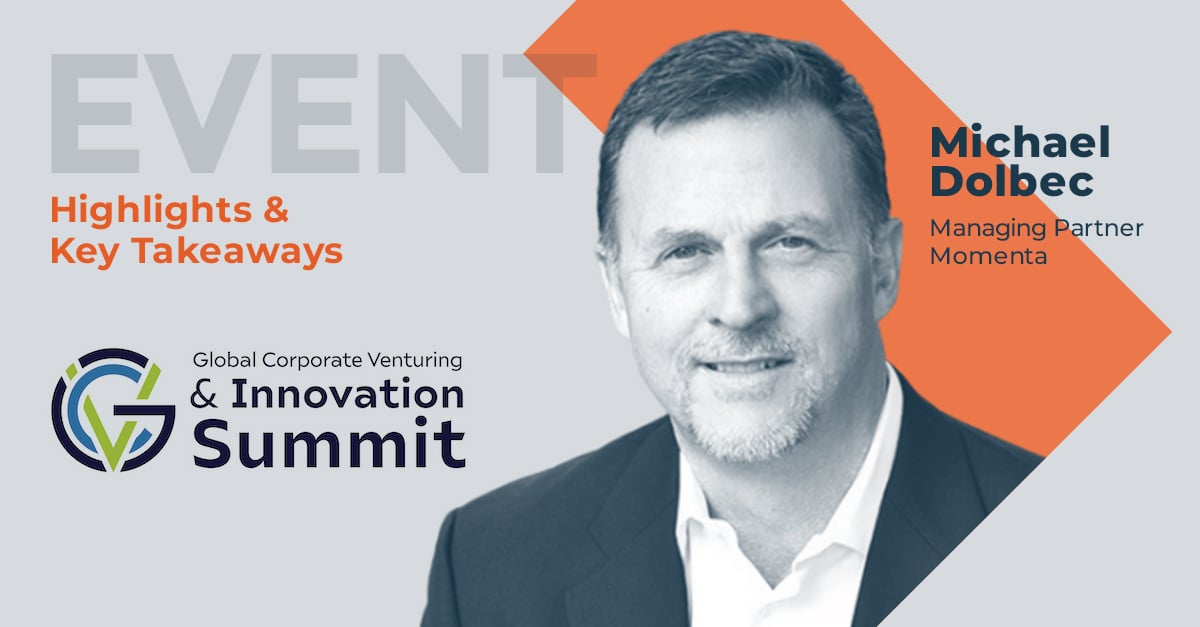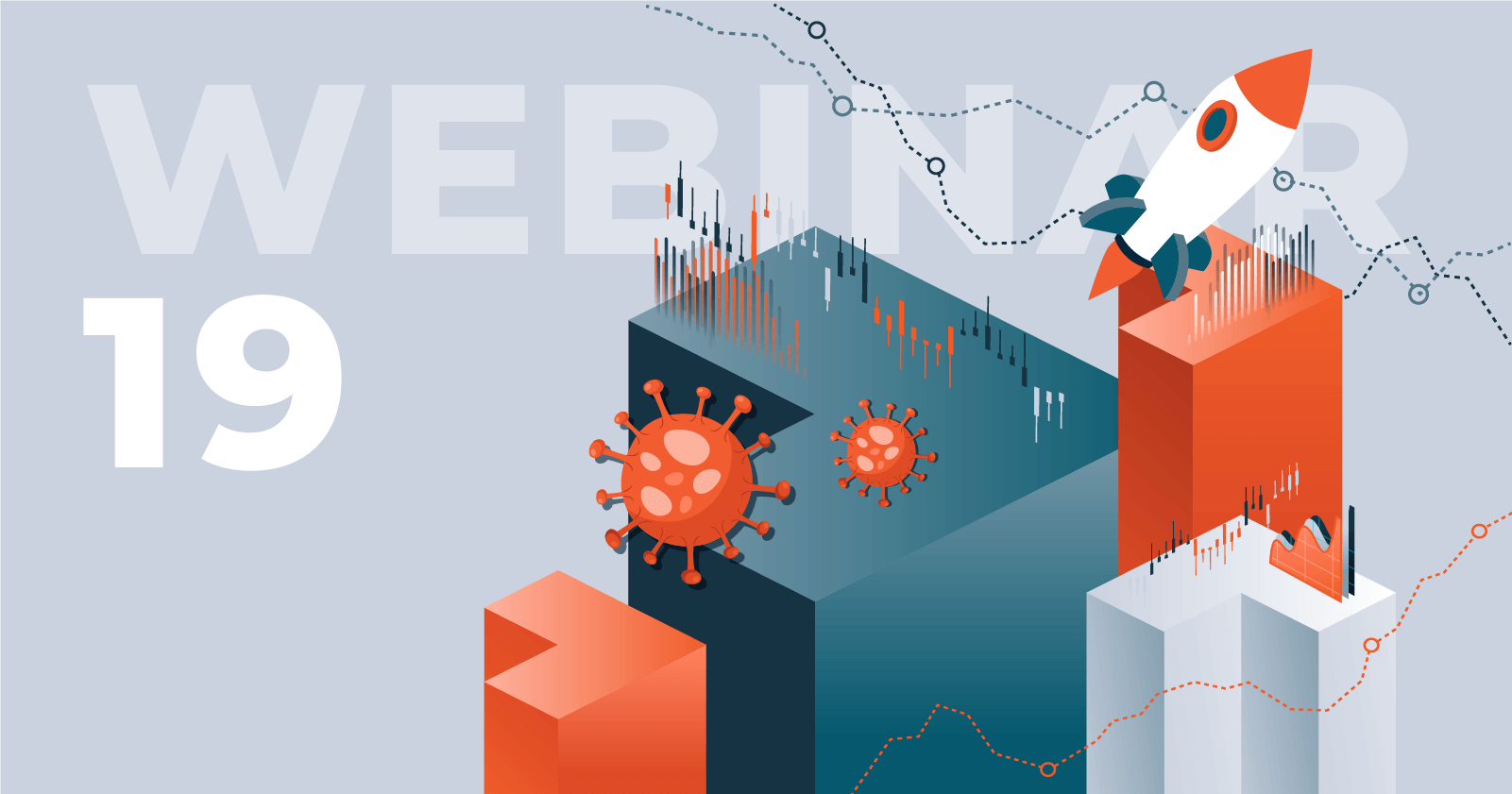Impressions
"IoT Week" in Montreal Part 1
Ed Maguire

Last week saw Momenta participation in two IoT related events: the Mnubo AIoT Summit and the McRock Capital Industrial IoT Symposium. The Mnubo AIoT Summit included three panels moderated by Ed Maguire of Momenta, followed by a workshop for the attendees. There were approximately 75 in attendance, and the feedback from the event was enthusiastically positive. Overall, the conversations highlighted the challenges involved with IoT-led digital transformation. Speakers at the McRock event covered a broad array of topics related to industrial IoT, and highlighted the financial progress in the market – as investment in IoT based startups has seen significant growth to an annual run rate of around $3.5 billion.
Mnubo AIoT Summit explores culture, business and technological change
The first panel on the topic of operational efficiencies and data-driven aftermarket services included panelists Marie-Pierre Bélanger of Pitney Bowes, Peter Grant of Decision Engines and Michael Young of Caterpillar Inc. All the panelists shared their experiences and perspective on the stages of turning data into valuable insights, the changes involved applying data to after market services, and the challenges to the organization, channel and business model when making this transition.
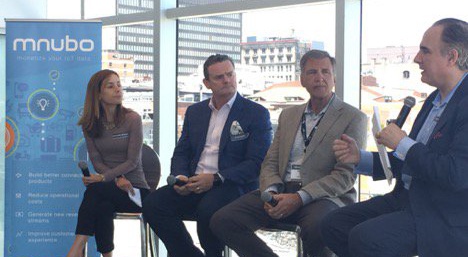
The panel ‘Monetize your IoT investment’ focused on ways that companies can turn their data into incremental business opportunities. Jocelyn Boudreau of Hortau shared how the company uses AI and IoT drive productivity and efficiency in connected agriculture. Sahir Sait of Ayla Networks shared how their platform helps customers use predictive replenishment to optimize aftermarket opportunities. VC Jean-Francois Marcoux of White Star Capital shared the view that the impact of AI on IoT will be transformational.
The final panel on the operational challenges of building an IoT strategy focused on culture, organization and the challenges of disruptive innovation for established companies. Shane Velen of Velen shared how his company adopted strategies from the book Exponential Organizations by Salim Ismael, building a team at the edge of the organization. Eugene Kawamoto of Soracom highlighted the key role of connectivity in deploying IoT solutions. Giovanni Iacovino of Dorma Kaba shared that disruptive innovations was most effectively conducted by a small team, away from the legacy organization in order to avoid the resistance and cultural differences when adopting new technologies and business models.
IoT Reality Check: “B-minus”
At the McRock Summit, Maciej Kranz, VP of Corporate Strategic Innovation at Cisco provided an overview of the state of the Internet of Things.In his view, we are currently rating at around a B-minus because IoT has been more challenging than initially thought. The rate that objects are being connected is robust, and the goal of IoT devices has been to generate data that can drive system that power business outcomes.
The worst of the hype is over with the massive predictions of connected devices. While a lot of headlines are focused on the consumer, the majority of revenues are coming from the business space including the industrial markets. The initial goals were to improve existing processes, but we are moving into new business models and ideas. In connected operations, Harley Davidson was able to reduce the configuration of a bike from 18 months to 2 weeks, troubleshoot problems in manufacturing and improve the bottom line by 30-40%. Another example is Nimble, a 150-store ice cream chain in India that installed sensor to notify people in stores of power outages with 500% ROI. GM and FANUC have been able to anticipate 100 line stoppages to save $2mn each stoppage. Goldcorp has used PdM to anticipate 80% of potential equipment failures three months in advance, averting a $2mn loss each occurrence.
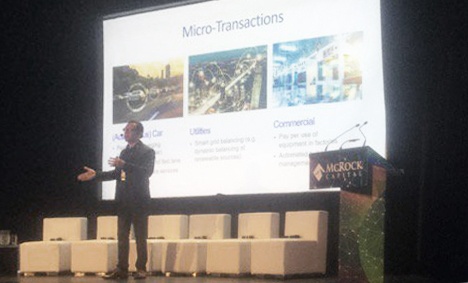
“IoT is the body – and AI is the brain”
Maciej believes that IoT is not transformational by itself- the impact is combinatorial with Fog Computing, AI and Blockchain. Almost every company is incorporating AI (the brain) and IoT (the body). AI is useless without the right data at the right time and format. Blockchain hype has exceeded IoT, but it’s the underlying technology for trust that enables new applications in supply chain (visibility, provenance and trace and trace are useful). In the chip industry there’s $7.5bn lost to counterfeits every year. Food safety, patient records and privacy are promising use cases as are intelligent autonomous drones. IoT is about driving business results. Micro transactions will enable possibilities in autonomous transportation, smart cities and other areas.
His view is that we need to think big but start small. C-suite sponsorship is critical for success, along with building teams internally. Failures are a part of the process – and it’s often hard for companies to admit failure. Common failure comes from not tying in business results, separating science projects from production deployments and using immature technologies.
From closed to open systems
There’s been a big transformation in market structures from proprietary to open systems – from on vendor solutions to ecosystems, this is taking place in industrial technology now – and it’s driven by the customers. Open systems and standards encourage interoperability.
The New Co-Economy is centered around a change of roles and the balance of power as buyers and sellers are collaborating. Another big challenge is finding the right people – IoT is really about people and these businesses are creating new roles. Security remains a big challenge, and every major security company has IoT solutions. Consumer device makers still have a lot of ground to cover to improve security. On the industrial side there’s growing awareness that security by obscurity is not a viable strategy. There’s been a shift in operation technology from denial to a comprehensive approach to prevent hacking.
How investors view IoT opportunities
An investor huddle included Christina Russ from Samsung Next, Senia Rapisarda from HarbourVest, Amit Chaturvedy from Cisco, Dr. Yvonne Lutsch from Bosch ad Frank Andrasco from Next 47. The panelists shared investing moments that excited them. Next47 had met a team from Seeq out of Honeywell and put them in front of process manufacturing team – they wanted to compare different batches by comparing historian data. The entrepreneurs solved the problem of time series analysis that confounded internal Ph.Ds. Bosch is looking at a team that’s solved a problem in autonomous driving space that corporate and institutional investors are lining up for. Cisco invested in Kespry, which provides aerial intelligence from drones. A lot of drone companies had been slow to scale because of FAA regulations and other challenges, and Cisco believes they are a real breakaway company.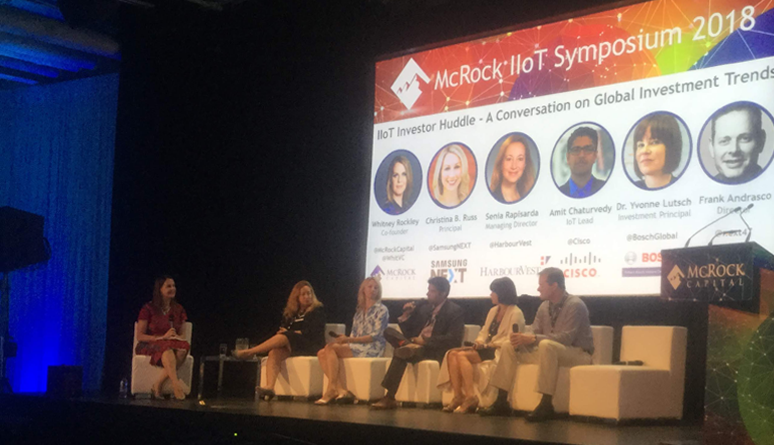
There’s a changing landscape in the market – with more big players investing at the edge. A lot of IoT over the last 30 years was about analytics and insights, and ROI took longer to play out. Now cloud players want to do more at the edge and transport all the data back to the cloud. If all the data goes back to the cloud it’s not free. While more vendors are jumping in at scale, no one has fully proved out ROI – this has to be proven vertical by vertical. Geographically, there’s a lot of IoT Security from Israel. China is taking the lead in the connected car market with funds and startups, India is focusing on basic logistics and Japan is focused on robotics with gripper technologies and dexterity.
Scaling the industry
Bosch is a large producer of MEMS sensors where they produce 5 million per day that need to be connected. Solutions need to be plug and play. HarbourVest has been implementing an Operational Due Diligence template with a checklist to help entrepreneurs has out their processes. Next47 noted that with technical products – “your product may threaten the only people that understand it” – the only people that understood the ROI of a technology often are those that are responsible for buying it. You have to work with people that are threatened by the ROI and you have to work with them as the gatekeepers. For Cisco post Jasper, it’s been a challenge to identify the next platform opportunity.
Smart Cities – A Global Race to Digital Urbanization
The Smart Cities panel included Dan Riegel from Sidewalk Labs, Kurtis McBride from Miovision, Ignasi Vilajosana from Worldsensing and Ian Slesser from Pitney Bowes. Smart Cities have been a brand for a while, but for smart cities to emerge as a “thing” we need an architecture. HTTP unlocked the web, but we need a protocol layer to emerge for cities – this could be more like an operating system or more like the Internet. The version of the OS today for cities is like the old AOL discs – where the Internet ultimately prevailed. Sidewalk Labs see that there will not be a monolithic approach to smart cities. The term has a bit of hubris, and Sidewalk is approaching with humility to appreciate the mistakes and lessons from the past.
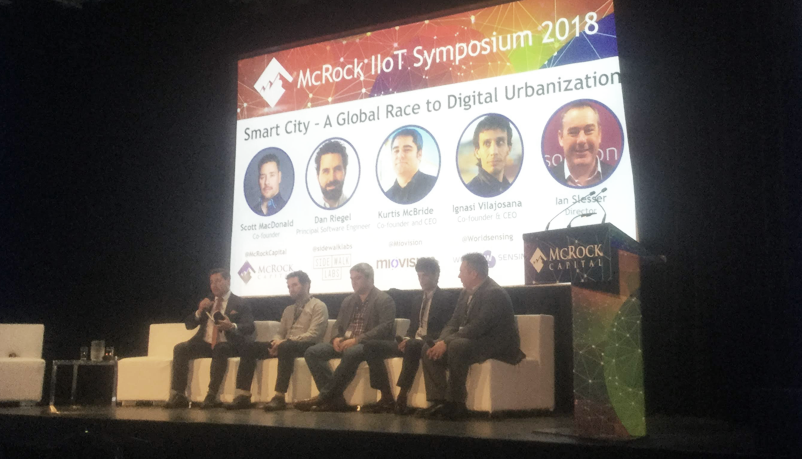
One of the dilemmas around smart cities is understanding who pays. This differs across applications – for instance parking versus intersections (beneficiaries might be citizens for emergency response or courier companies). Challenges of IoT adoption are amplified because they need to show a clear payback. Solutions with clear ROI are adopted first. Worldsensing is seeing private sector entrants into public services. Public servants are showing concerns over disintermediation of services, and the only thing they can do is regulate. Ian Slesser of Pitney Bowes shared that Pitney has actually been monitoring assets for over 10 years and covering over 55% of roads in the UK. No one actually knows what Smart Cities means – previously it was about monitoring, now it’s about solving problems.
Worldsensing shared how the city of Bogota, Colombia has integrated data across multiple areas of the city to evaluate if situations are abnormal. They have reduced police response to a traffic incident from twelve to eight minutes, with thirty people managing responses for the entire city. There a big mind shift to make these systems work. The sheer volume of data from a city is almost impossible to understand in raw form – the value of a system that can profile and analyze what situations are normal and what needs to be done.
Miovision has been working with Detroit for the past 3 years – the traffic operations team had no connectivity or sensors and were in a state of bankruptcy, their problem was rolling brownouts that would cause signals to go into flash. They installed a “smartphone for intersections” that provided a text message when the power went out. They began mapping the data, and they saw that the software could change over time - this changed the mindset with the city. About two weeks ago they launched the most sophisticated network in North America for smart intersections, and now they are using the most advanced technology at a fraction of prior cost. All of the panelists agree that there’s big opportunity for cities to be the next platform for innovations.

